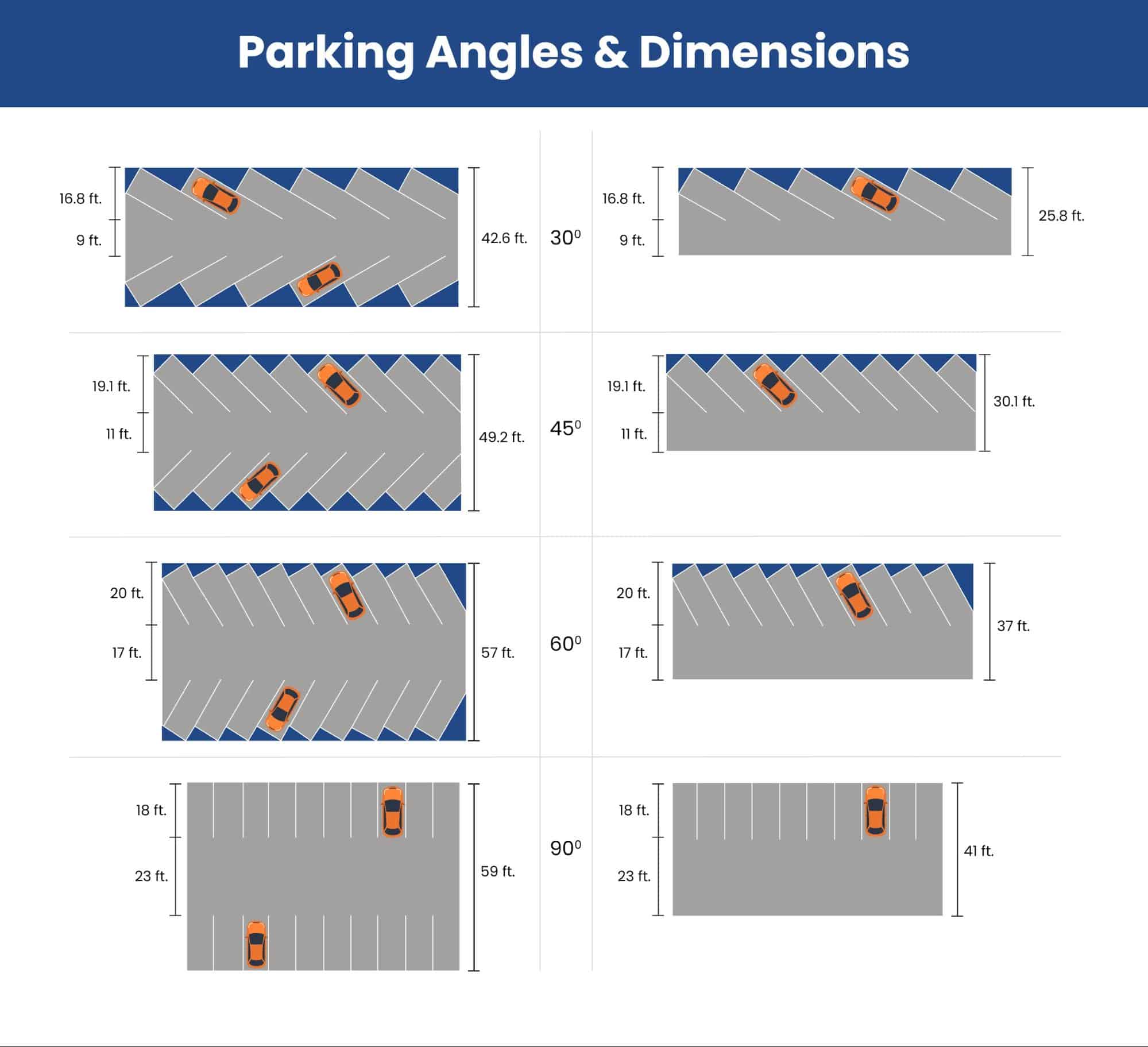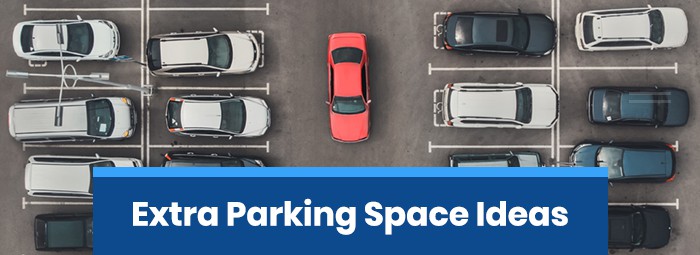When your current parking space is not enough, you may be forced to look for extra parking space elsewhere, which can be expensive and risky. The lack of enough parking space in a commercial space can also turn off customers.
Fortunately, there are several ways of creating an extra parking space, whether for a residential or commercial facility. To get the space, you can use the available space and make it more accommodating or create an extra one. Read on to learn some top ideas on how you can do that.
Why Do You Need More Parking?
You may need more parking for various reasons:
- Do you want more parking to generate revenue?
- Do you want more parking for personal use?
- Do you want more parking for public use?
- Do you need more parking space to accommodate more vehicles at a time?
- Or do you need more parking space to accommodate larger vehicles?
Configuring private parking for personal use will differ from configuring public parking for generating revenue in terms of dimensions and layout. The space and dimensions to accommodate larger vehicles will slightly differ from accommodating a greater number of vehicles in terms of maneuverability.
5 Considerations When Planning a Parking Area
The 5 important things to keep in mind when planning a parking area include:
- The dimensions of the available parking space
- The purpose of the lot
- Maintenance of the lot, such as surface cleaning
- Security of the parking lot
- Accessibility of the parking area

How Do You Make an Extra Parking Space?
5 tips to make an extra parking space include:
1. Configure The Lot to Save Space
You can configure your lot to save space by adjusting your parking layout and angle. To do this, you can adjust the space to 30, 45, 60, or 90 degrees. The parking angle you choose can make a big difference, as it dictates how many cars can be parked in a particular space.
- The 30 degree parking angle is one of the most common. Its advantage is that it offers better maneuverability. However, only a few cars can be parked.
- The 45 degree parking angle is also pretty common. It can hold more cars than the 30 degree angle and still keeps things moving smoothly. This parking angle is very common in busy areas such as grocery stores and malls.
- The 60 degree angle accommodates more vehicles than the 30- and 45-degree angles. However, it requires a lot of aisle space
- 90° Parking Spaces – Also known as perpendicular parking, this is usually the most space-saving form of parking, but it also creates greater opportunities for crashes and collisions.
- Parallel Parking Spaces – Works well in narrow, linear lots, which are also space-efficient. But many drivers find it difficult to maneuver into parallel spaces and can cause issues with traffic.
2. Decrease Spot Size to Increase Spot Number
You can increase the number of parking spots by decreasing the sizes of the available spots. However, this is only suitable if the spots are already a large size, or you don’t need a lot of extra spots. If you decrease the size of standard-size spots it may be more difficult for large vehicles to park.
3. Share Parking Space with Neighbors
You can share a parking space with neighbors if it is possible. They can park at your premises if it’s not full, and you can also park at theirs. This may include creating a schedule or assigned spaces. You just need to have an agreement.
4. Make Use of Adjacent Space
If you have the available real estate, creating more parking can be as simple as expanding the parking spots into the adjacent space if it’s not utilized. Make sure it’s not obtrusive to others or limits their accessibility to the property. If the surface is untreated, you can distinguish as parking with surface treatments such as:
- Concrete
- Pavers
- Gravel
- Brick
- Mulch
For the sake of both safety and convenience, you should make it clear that the intended use of land is a makeshift parking spot with signs, barriers, and pavement markings.
5. Implement Parking Rules
Assigned parking, a parking schedule, or time limits are all methods to make parking more available. Using a parking schedule or time limits can help economize a limited number of parking spaces. Parking in shifts means more people can park in rotation. A parking schedule and time limits are usually required with a double parking layout to ensure that people don’t become trapped by others’ cars.
Common Parking Questions
1. Does An Extra Parking Space Add Value?
Since more parking spaces are a commodity, a parking space adds value to your property. Paved, off-street parking is particularly valuable, especially in busy cities. Properties with parking facilities fetch higher prices than those without. Reports indicate that a parking space can increase the value of a home by 5%.
2. What Are 3 Types of Parking Spaces?
Most parking spaces falls into one of the following 3 categories:
- Parallel Parking Spaces – Vehicles are parked parallel to the curb or wall in parallel parking spaces. Parallel parking is quite easy, but a driver has to be careful not to damage the alloy wheels by getting too close to the curb.
- Perpendicular Parking Spaces – In perpendicular parking spaces, the parking spaces are usually at 90 degrees to the curb or wall, but include angled parking at 30, 45, or 60 degrees.
- Double Parking – In double parking, a vehicle is parked parallel to another car parked on the curb. Double parking can also be used to refer to when a vehicle is parked in such a way that it occupies multiple parking spaces. This happens when a driver fails to park their vehicle properly.
What Are the Problems in Parking?
Parking has its share of challenges. These include:
- Accessibility problems that make it difficult for one to get to and from their car
- Congestion due to inefficient configuration
- Poor visibility and maneuverability, making accidents and damages more likely to occur
- Inadequate parking whereby the available parking space is not adequate for all the vehicles
What Is a Parking Management System?
A parking management system is a program used to manage parking spaces, mostly on commercial premises. These systems help large enterprises manage parking spaces more easily and efficiently. Parking management systems also help maintain a good customer parking experience.
These systems offer solutions to both parking owners and customers. The business owner doesn’t have to do everything manually, saving them time. The customers also benefit since they don’t have to spend much time looking for a parking space.
Which Type of Parking Is Best?
You have to determine some factors when deciding the best parking that suits your space. Generally, ensure that the design you settle for utilizes the available space maximumly and is safe and comfortable for your customers.
How Can You Earn Extra Revenue from Your Parking Lot?
Entire businesses are formed around providing parking and parking management services.
- If you have the available real estate, you can turn it into a parking lot.
- You can make money from renting your single parking spot.
- If your current parking lot is not in use, advertise it as available parking and charge a fee.
Thanks to technological advancements, generating revenue from parking is easy. There are several websites that allow you to advertise your space at a commission.
Keep Your Parking Lot & Driveway Clean with PDX Prowash
After expanding your parking, you need to keep it clean. A clean parking lot leaves a good impression on your customers. Additionally, it extends the life of your parking, and reduces maintenance needs. On top of that, it keeps lines and signs easy to read, promoting proper parking, especially in areas with heavy vehicle and pedestrian traffic. PDX Prowash offers parking lot cleaning services, as well as commercial power washing and residential power washing services. Contact us today to learn more!

